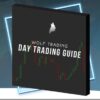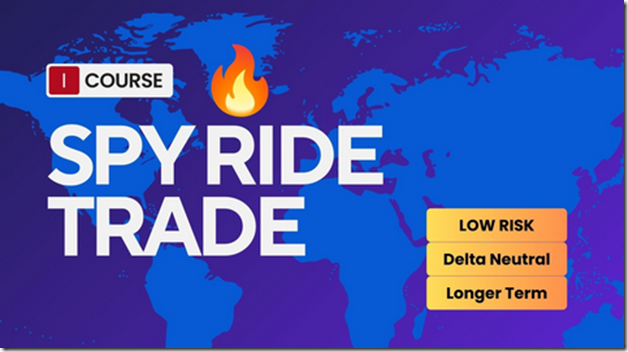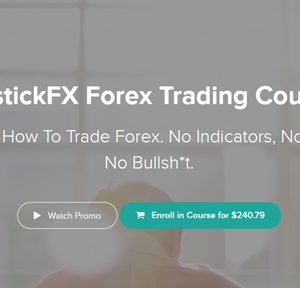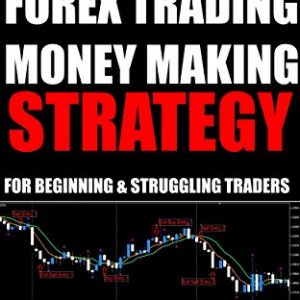My Options Edge – Stock Options Strategy – The Ride Trade
$25.00
Table of Contents
The Ride Trade – Options Income Strategy That Delivers Results?
This article delves into The Ride Trade, a proprietary stock options strategy developed and actively traded by the instructor at My Options Edge. It aims to provide a comprehensive overview of this strategy, its purported benefits, risks, and suitability for different types of traders.
The Ride Trade
The Ride Trade strategy, as advertised by MyOptionsEdge.com, presents itself as a pathway to consistent monthly income through carefully constructed Calendar Spreads on SPY and QQQ ETFs. The core promise revolves around capturing profits primarily from time decay (Theta) and benefiting from increases in implied volatility (Vega), all while maintaining a Delta Neutral position. The strategy hinges on selecting longer-dated options to minimize the impact of short-term market fluctuations. The developer claims that the king of my trading strategies is delivering exceptional results. A key strategy of my Hedge Fund. But is this a legitimately effective method, or just another overhyped “get rich quick” option trading scheme? Let’s break down the details and explore what makes this Ride Trade tick, or if whether it will make you sick.
The Mechanics of the Calendar Spread
The foundational element of The Ride Trade lies in the strategic implementation of Calendar Spreads. This involves simultaneously buying and selling options with the same strike price but different expiration dates. The seller is usually a short-term holding and the buyer is long-term holding to generate income. The selection of specific strike prices is driven by the option Delta, a measure reflecting the sensitivity of an option’s price to changes in the underlying asset’s price. By carefully managing these parameters, the strategy aims to achieve Delta Neutrality, mitigating the impact of directional price movements on overall profitability.
Calendar Spreads, in general, are designed to profit from the time decay of the short-dated option, particularly as it approaches its expiration date. The longer-dated option acts as a hedge, protecting against unexpected price swings. A successful Calendar Spread trade requires a careful assessment of market conditions, volatility expectations, and the precise timing of entry and exit.
However, the risk in calendar spread trades can be adjusted with a strategy. The main problem with calendar spread are you need to manage your trade to get the full profit. It can also be adjusted with directional assumption depending on the market condition at the moment trade is entered.
Theta and Vega: The Engines of Profit
The Ride Trade relies heavily on the combined forces of Theta and Vega for profit generation. Theta represents the rate at which an option’s value decays as time passes. In a Calendar Spread, the short-dated option experiences faster Theta decay than the longer-dated option. This differential decay is the primary source of profit for the strategy. As time elapses, the short option loses value more rapidly, allowing the trader to capture the difference.
Vega, on the other hand, measures an option’s sensitivity to changes in implied volatility. A positive Vega position implies that the option’s value will increase as implied volatility rises and it will lose value if implied volatility decreases. The Ride Trade, according to its description, aims for positive Vega, enabling it to benefit from increasing volatility. However, this also means that the strategy is vulnerable to losses if volatility declines.
Theta and Vega are interconnected forces. When implied volatility is high, options premiums tend to be higher, leading to greater Theta decay. Conversely, when implied volatility is low, options premiums are lower, reducing the potential profit from Theta decay. The optimal scenario for achieving profits in options trading is typically a stable to moderately increasing implied volatility environment.
Analyzing the 2021 Performance Data
The My Options Edge briefing document highlights the performance of The Ride Trade in 2021, claiming 26 profitable trades with cumulative profits of $7,700 from an average investment of $4,500 per trade. The data suggests an average profit of $400 per winning trade and an average loss of $350 per losing trade. While these numbers appear impressive, it’s crucial to approach them with careful consideration. The source emphasizes its real-world application, stating, “The king of my trading strategies is delivering exceptional results. A key strategy of my Hedge Fund.”
Past performance, as always, is not indicative of future results. 2021 was a unique year characterized by specific market conditions that may not be replicated in the future. Factors such as exceptionally low interest rates, government stimulus measures, and the rapid recovery from the COVID-19 pandemic contributed to a highly favorable environment for many trading strategies.
When evaluating any options strategy’s historical performance, it’s essential to consider factors such as the sample size of trades, the consistency of results across different market conditions, and the potential for adjustments or modifications to the strategy over time.
My Options Edge
The promise of a structured options course and a thriving community are central tenets of My Options Edge. The platform not only offers a description of The Ride Trade strategy in PDF format but also provides exclusive access to a Trading Community on Discord, an environment where participants can connect with the instructor. Subscribers can follow the instructor’s real-time trades derived from his hedge fund, adding a live, hands-on element to the educational experience. Let us see the community and the course offer.
The Course Structure and Content
My Options Edge’s strategy is delivered through a detailed PDF document, offering an in-depth explanation of the various components that make up The Ride Trade. From the intricacies of Calendar Spreads to the nuances of Delta Neutral positioning, the course aims to provide a holistic understanding of the strategy’s underpinnings.
The content extends beyond theoretical concepts, encompassing practical aspects such as strike price selection, adjustment techniques, and risk management protocols. The instructor emphasizes the dynamic nature of the strategy, highlighting the need for flexibility and adaptability in the face of evolving market conditions.
However, the value of any course ultimately depends on the clarity of its explanations, the depth of its coverage, and the practical applicability of its teachings. A well-structured course should empower students to not only understand the theory behind a strategy but also to implement it effectively in real-world trading scenarios.
Learning and Community: The Power of Interaction
Access to the My Options Edge Trading Community on Discord is a key element of the offering. This is where subscribers supposedly interact with the instructor and follow his real-time trades. This feature enables traders to get practical learning and supports along his real time trades. The real-time trading room provides a unique opportunity to observe the instructor’s decision-making process and gain insights into the practical application of The Ride Trade strategy.
Learning from experienced traders and participating in a supportive community can be invaluable for aspiring options traders. This interaction enables knowledge sharing, fosters collaboration, and provides a platform for addressing questions and challenges.
However, the value of a trading community also hinges on the quality of its members and the level of engagement it fosters. An active and supportive community can significantly enhance the learning experience, while a less engaged or poorly moderated community may offer limited benefits.
Transparency and Real-Time Trade Updates
My Options Edge attempts to distinguish itself by ensuring that subscribers get detailed explanations of each trade. This includes the rationale behind the trade, screenshots of the options structure, filled orders, position status with adjustments, and profit targets. The goal is to shed light on the decision-making process and provide transparency into the execution of The Ride Trade.
This level of transparency can be highly beneficial for traders seeking to emulate the strategy. By understanding the factors that influence each trade, subscribers can gain a deeper understanding of the strategy’s nuances and potentially adapt it to their own unique circumstances.
However, even with complete transparency, it’s important to remember that every trader’s situation is different. Factors such as risk tolerance, capital allocation, and trading experience can all influence the suitability of a particular strategy.
Stock Options Strategy
A stock options strategy, by definition, involves the use of options contracts to leverage, hedge, or generate income from the movements of underlying stocks or indices. Developing a robust strategy requires a solid understanding of options pricing, risk management, and market dynamics. The Ride Trade is also a stock options strategy.
Understanding Options Basics
Options contracts grant the holder the right, but not the obligation, to buy (call option) or sell (put option) an underlying asset at a specified price (strike price) on or before a specified date (expiration date). Options derive their value from several factors, including the price of the underlying asset, the strike price, the time to expiration, and the implied volatility of the underlying asset.
Understanding the intricate relationship between these factors is crucial for developing and implementing successful options strategies. Traders must also be aware of the various risks associated with options trading, including the potential for significant losses and the time decay of options value.
When evaluating an options trading strategy, it’s essential to consider its underlying assumptions, risk parameters, and potential for adaptation to different market conditions. A well-designed strategy should incorporate mechanisms for managing risk, adjusting positions, and adapting to changing market dynamics.
Delta Neutrality: Aiming for Balance
Delta Neutrality is a risk management technique that aims to minimize the impact of directional price movements on a portfolio. Achieving Delta Neutrality involves balancing the deltas of various options positions to create a portfolio whose value is relatively insensitive to short-term price fluctuations in the underlying asset.
The Ride Trade aims for Delta Neutrality, which indicates that the strategy is designed to profit primarily from the passage of time and changes in implied volatility rather than directional price movements. It suggests that that we do not need to be stressed about the market not moving (Delta) as time passes. In the Ride trades, we are on the right side as time passes, capturing profits.
Delta Neutral trading can be a complex and challenging endeavor. It requires careful monitoring of portfolio deltas and frequent adjustments to maintain the desired level of neutrality. Traders must also be aware of the potential for gamma risk, which arises from the fact that the delta of an option changes as the price of the underlying asset moves.
The Importance of Risk Management
Risk management is the cornerstone of any successful options trading strategy. Options trading inherently involves significant risks, including the potential for substantial losses and the time decay of options value.
My Options Edge does state that there are no risk-free options strategies! acknowledging the inherent risks in options trading. So it is important to employ robust risk management techniques to mitigate these risks and protect trading capital.
Effective risk management involves setting appropriate position sizes, establishing stop-loss orders, and diversifying portfolios across different assets and strategies. Traders should also be aware of the potential for unexpected market events and be prepared to adjust their positions accordingly.
When evaluating an options trading strategy, it’s essential to assess its risk management protocols and determine whether they are adequate to protect against potential losses. A well-designed strategy should incorporate mechanisms for managing risk, adjusting positions, and adapting to changing market dynamics.
Calendar Spreads: A Deeper Dive
Calendar spreads are an integral part of The Ride Trade. It consists of simultaneously buy and sell options with the same strike price but different expiration dates and try to get profit with the underlying.
Calendar spreads are used for profit by the time decay of short term contract. However, Calendar Spreads expose traders to several risks, including the potential for losses if the price of the underlying asset moves significantly in either direction. Managing strike prices is important otherwise you could lose value quickly.
When constructing a calendar spread, it’s important to carefully consider the strike price, expiration dates, and the implied volatility of the options. Traders should also be aware of the potential for early assignment of the short-dated option, which can result in unexpected losses.
The Role of Implied Volatility
Implied volatility (IV) plays a crucial role in options pricing and strategy development. The Ride Trade is best used in a low IV market environment or in an increasing IV. The positive Vega component allows it to benefit from rising volatility. Not all traders check implied volatility during implementing stock options strategy.
It represents the market’s expectation of future price volatility. High implied volatility indicates that the market expects significant price fluctuations, while low implied volatility suggests that the market expects relatively stable prices.
IV is used the sensitivity of an option’s price to changes in implied volatility. A positive Vega position implies that the option’s value will increase as implied volatility rises and decrease as implied volatility falls.
When evaluating an options trading strategy, it’s important to assess its sensitivity to changes in implied volatility. Strategies with positive Vega are generally favored in environments where implied volatility is expected to increase, while strategies with negative Vega are preferred in environments where implied volatility is expected to decrease.
Conclusion
The Ride Trade, offered by My Options Edge, presents itself as a structured approach to generating income through Calendar Spreads on SPY and QQQ ETFs. The strategy focuses on capitalizing on Theta decay while maintaining Delta Neutrality and benefiting from positive Vega. But the key is whether is it realy profitable and will bring consistent in time.
The success of any stock options strategy depends on various factors, including market conditions, risk management, and the trader’s ability to adapt to changing circumstances. While the 2021 data may appear promising, it’s crucial to approach it with caution and consider its limitations.
Ultimately, the decision of whether to pursue The Ride Trade or any other options strategy should be based on a thorough assessment of individual risk tolerance, investment goals, and trading experience.
Sales Page: _https://www.myoptionsedge.com/ride-trade-best-option-strategy
Be the first to review “My Options Edge – Stock Options Strategy – The Ride Trade” Cancel reply
Related products
Forex & Trading
Forex & Trading
Forex & Trading
Forex & Trading
Forex & Trading
Forex & Trading












Reviews
There are no reviews yet.